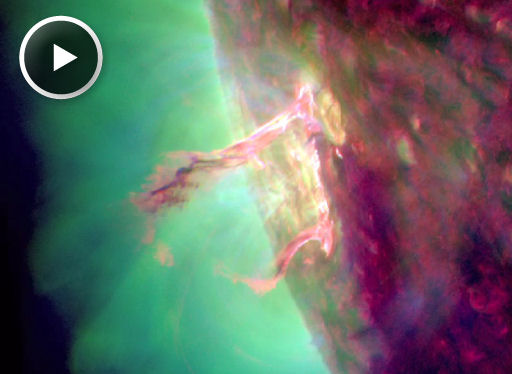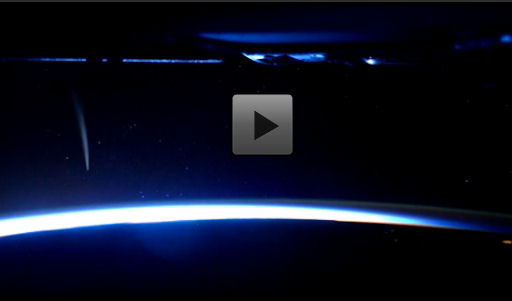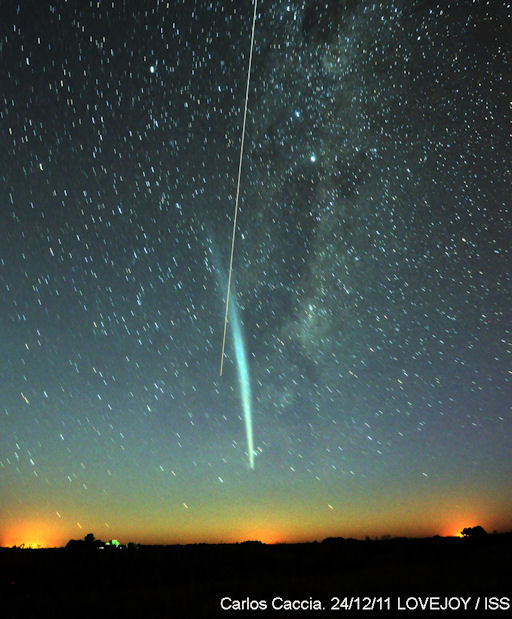~Space Weather Update~CHRISTMAS EVE ERUPTION~
LAST MINUTE ASTRONOMY GIFT: Running out of time? In only a few minutes, you can give the gift of Northern Lights, space station flybys, and other heavenly sights to friends and loved ones. Our unique astronomy alert services, Spaceweather Text and Spaceweather Voice, come with a handy e-Card for instant gift-giving.
CHRISTMAS EVE ERUPTION: A filament of magnetism connected to sunspot AR1386 erupted during the early hours of Dec. 24th. Extreme UV-wavelength cameras onboard the Solar Dynamics Observatory recorded the picturesque blast:
The C5-class eruption hurled a billion-ton coronal mass ejection (CME) into space, but not toward Earth. With the cloud sailing wide-left of our planet, Christmas geomagnetic storms are unlikely. Nevertheless, this active region merits watching as it turns toward Earth in the days ahead, possibly positioning itself for the first storms of 2012.
COMET LOVEJOY FROM ORBIT: Veteran astronaut Dan Burbank has seen many amazing things. Once, he even flew through the aurora borealis. So when Burbank says "[Comet Lovejoy] is the most amazing thing I have ever seen in space," it really means something. Currently serving onboard the International Space Station, Burbank photographed the sungrazing comet on Dec. 21st, an experience he describes in this NASA video:
Burbank describes the tail of Comet Lovejoy as a "green glowing arc at least 10 degrees long." He saw it just before orbital sunrise emerging from Earth's limb, which was "lit up as a bright sliver of blue and purple."
After plunging through the sun's atmosphere only 120,000 km above the stellar surface on Dec. 16th, and improbably surviving, Comet Lovejoy has become the finest comet since Comet McNaught in 2007. Its orbit is carrying it through the skies of the southern hemisphere where sunrise sky watchers are seeing the comet almost as clearly as Burbank did. One wonders if Burbank was looking out the window on Dec. 24th when Carlos Caccia took this picture of the ISS transiting Lovejoy's tail over Intendente Alvear, Argentina:
"The ISS passed through the Southern Cross, continued parallel to the Milky Way, and finally arrived at the tail of Lovejoy with its typical golden color," says Caccia. "What a lucky shot!"
The visibility of Comet Lovejoy should continue to improve in he mornings ahead as the comet moves away from the sun into the darker skies before dawn. Sky watchers should set their alarm for an early-Christmas treat.

Solar wind
speed: 360.8 km/sec
density: 5.2 protons/cm3
explanation | more data
Updated: Today at 1656 UT
X-ray Solar Flares
6-hr max: C4 1236 UT Dec24
24-hr: C5 0839 UT Dec24
explanation | more data
Updated: Today at: 1600 UT
![]()
Daily Sun: 24 Dec 11
New sunspot 1386 is crackling with C-class flares. Credit: SDO/HMI
![]()
Sunspot number: 123
What is the sunspot number?
Updated 23 Dec 2011
Spotless Days
Current Stretch: 0 days
2011 total: 2 days (<1%)
2010 total: 51 days (14%)
2009 total: 260 days (71%)
Since 2004: 821 days
Typical Solar Min: 486 days
Updated 23 Dec 2011
The Radio Sun
10.7 cm flux: 138 sfu
explanation | more data
Updated 23 Dec 2011
![]()
Current Auroral Oval:
Switch to: Europe, USA, New Zealand, Antarctica
Credit: NOAA/POES
![]()
Planetary K-index
Now: Kp= 0 quiet
24-hr max: Kp= 1 quiet
explanation | more data
Interplanetary Mag. Field
Btotal: 5.0 nT
Bz: 1.7 nT north
explanation | more data
Updated: Today at 1656 UT
![]()
Coronal Holes: 24 Dec 11
A solar wind stream flowing from this coronal hole could reach Earth between Dec. 27th and 30th. Credit: SDO/AIA






